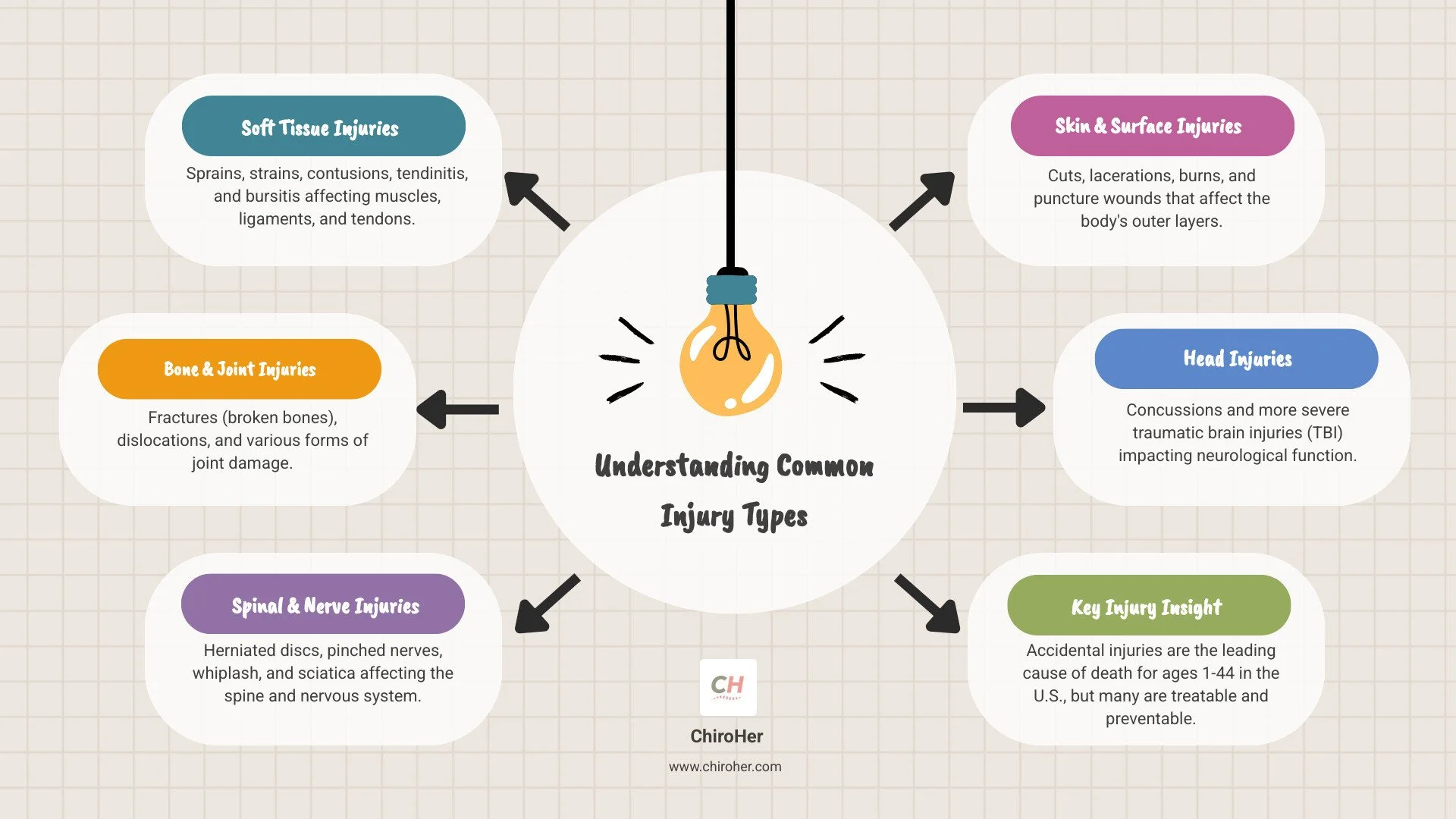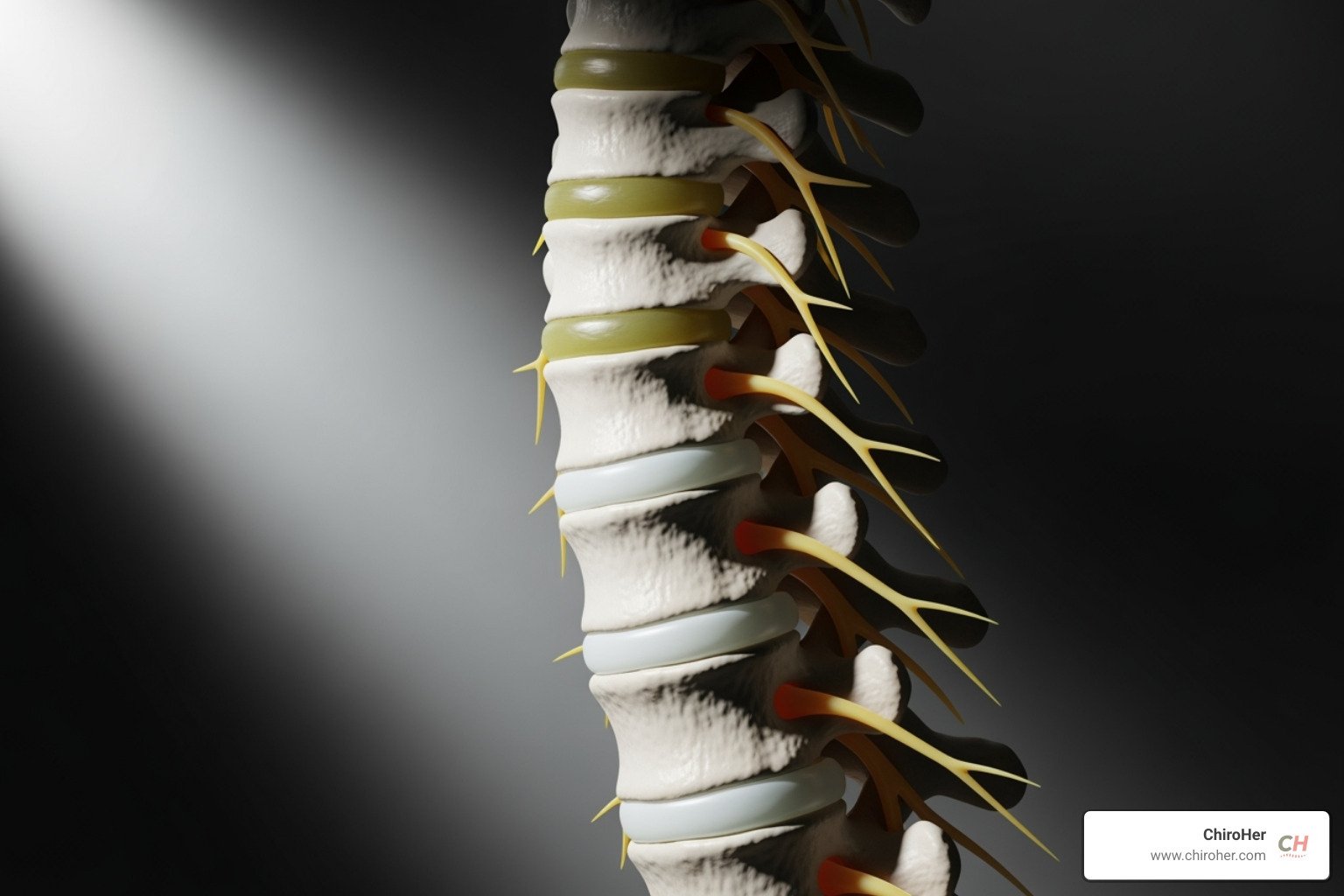The Ultimate Injury List: What Hurts and Why
Hi! I'm Dr. Michelle Andrews. Let's Talk About Injuries.
Different types of injury affect millions of Americans every year. From sports injuries to car accident trauma, understanding what's happening in your body is the first step toward healing.
Here are the main categories of injuries:
Soft Tissue Injuries:
Sprains and strains
Contusions (bruises)
Tendinitis and bursitis
Bone and Joint Injuries:
Fractures (broken bones)
Dislocations
Spinal and Nerve Injuries:
Herniated discs and pinched nerves
Whiplash and sciatica
Skin and Surface Injuries:
Cuts, burns, and puncture wounds
Head Injuries:
Concussions and traumatic brain injury
While accidental injuries are a leading cause of death for people under 44, many are treatable and preventable. As a chiropractor, I've seen how proper care can make the difference between chronic pain and full recovery. My experience with athletes, pregnant women, and busy professionals has taught me that every injury has a story, and understanding it is key to healing.
Soft Tissue Injuries: The Aches and Pains of Daily Life
If you've ever twisted an ankle or pulled a muscle, you've had a soft tissue injury. These types of injury affect our muscles, ligaments, and tendons. Most respond well to care, but they can become stubborn if ignored.
You've likely heard of the RICE method: Rest, Ice, Compression, and Elevation. This is a great first step, but it's just the starting point. Many people get stuck in the rest phase and don't progress to proper healing, which is where comprehensive care becomes so important. Can chiropractors treat soft tissue injury? The answer might surprise you.
Sprains and Strains
People often confuse these, but they affect different parts of your body. Sprains damage ligaments (which connect bone to bone), while strains affect muscles or tendons (which connect muscle to bone).
Sprains often happen when a joint, like an ankle, is twisted, stretching or tearing the ligaments. This causes pain, swelling, and difficulty putting weight on it.
Strains occur when a muscle is overstretched, like a pulled hamstring from sudden movement. This can happen from lifting something too heavy or being a "weekend warrior."
Understanding the Difference Between Sprains And Strains is helpful. For more serious tears, patients often ask What Can A Chiropractor Do For A Torn Muscle? The answer involves more than just waiting.
Cuts, Scrapes, and Puncture Wounds
These surface-level types of injury are important to handle correctly because broken skin can lead to infection.
Cuts (lacerations) are from sharp objects.
Scrapes (abrasions) happen when skin rubs against a rough surface, exposing many nerve endings.
Puncture wounds from nails or bites can push bacteria deep into tissues.
The key is thorough cleaning. Minor wounds can be handled at home, but deep or heavily bleeding wounds need professional care. For guidance, see First Aid for Cuts and Scrapes and First Aid for Puncture Wounds.
Overuse and Repetitive Strain Injuries
These slow-burn types of injury develop gradually from repetitive motions.
Tendinitis is tendon inflammation, common in conditions like tennis elbow or Achilles tendinitis. You don't have to be an athlete to get it; typing can cause it too.
Bursitis affects the bursae, small fluid-filled sacs that cushion joints. Repetitive pressure can cause them to swell and become painful.
Rest alone is often not enough for these injuries. It's important to identify the root cause, such as poor posture or muscle imbalances. Chiropractic Care for Tendonitis can address these underlying issues, and we also explore supportive treatments like asking Does Kinesio Tape Help Shin Splints.
A Guide to the Most Common Types of Injury to Bones and Joints
When your body's framework of bones and joints is damaged, the impact is often immediate. Types of injury affecting these structures require prompt medical attention because they involve complex healing processes.
The most common bone and joint injuries are fractures and dislocations. They can happen suddenly from trauma or develop over time from repetitive stress. These injuries are challenging because they often damage surrounding muscles, ligaments, and nerves.
Fractures: Understanding Broken Bones
A fracture is a broken bone. They can happen instantly with a loud crack or develop slowly as a dull, worsening ache.
Acute fractures result from a single, powerful force, like a fall or sports impact. Symptoms include severe pain, swelling, visible deformity, and inability to use the injured area.
Stress fractures are tiny cracks from repetitive force, like a runner developing them in their shins. The pain starts mild and worsens with activity.
Both types require medical evaluation, often with X-rays. Treatment may involve a cast or splint, and sometimes surgery. Healing can take weeks or months. Learn more about Acute Fracture Meaning.
Dislocations: When Joints Get Out of Place
A dislocation occurs when the bones in a joint are forced out of alignment. This is one of the more painful types of injury. Shoulders, knees, and fingers are commonly affected.
Symptoms are usually obvious: severe pain, visible deformity, and a complete inability to move the joint. You might also see swelling and bruising.
Dislocations need immediate medical attention to be "reduced" or put back into place. This should only be done by a professional to avoid more damage. After reduction, rehabilitation is key to regaining strength and stability. While we don't treat acute dislocations, chiropractic care is valuable during recovery to restore joint function. For ongoing issues, a Chiropractor For Joint Pain can help, and we also explore if a Can A Chiropractor Help With Frozen Shoulder.
Spinal, Head, and Nerve Injury Types
Your spine, head, and nervous system are your body's command center. When these areas are injured, the effects can ripple through your entire life. These types of injury can result from a sudden accident or from years of poor posture and repetitive stress.
Neck and Back Injuries
Your neck and back work hard every day. When they get hurt, the impact can be significant.
Whiplash is a common injury from car accidents, even minor ones. The head snaps back and forth, but symptoms like neck pain and stiffness might not appear for hours or days.
Herniated discs occur when the soft, jelly-like center of a spinal disc pushes out and presses on a nerve, causing pain, numbness, or weakness.
Tech neck is a modern problem caused by looking down at screens, which puts enormous strain on the cervical spine.
For more on spinal health, explore our resources on Back Injury and learn How Does Chiropractic Treatment Help In Alleviating Back Pain. We also explain the Whiplash Vs Concussion What's The Difference and discuss if Can Chiropractic Care Help With A Herniated Disc or provide Chiropractic For Neck Pain.
Nerve-Related Pain: Sciatica and Pinched Nerves
Nerve pain can be sharp, burning, or feel like "pins and needles." These nerve-related types of injury are frustrating because the pain often appears far from the actual problem.
Sciatica is irritation of the sciatic nerve, which runs from your lower back to your toes. This can cause pain anywhere along that path, often mistaken for a leg injury.
Pinched nerves happen when bone, muscle, or other tissue puts too much pressure on a nerve, disrupting its signals and causing pain, numbness, or weakness.
We offer solutions for How To Ease Sciatic Nerve Pain and answer if Can Chiropractors Fix Pinched Nerves. We also have information on Lumbago With Sciatica.
Head Injuries and Concussions
Head injuries are among the most serious types of injury because they involve the brain.
Concussions happen when the brain is shaken inside the skull from a blow or jolt. You do not have to lose consciousness to have a concussion. Symptoms can include headache, fogginess, dizziness, and nausea.
Traumatic brain injuries (TBI) are more severe and require immediate medical attention. The first hour after a TBI is critical for preventing further damage.
After a head injury, many people struggle with chronic headaches or dizziness. We address related issues, such as Can Chiropractic Help With Vertigo and Can Chiropractic Treatment Help Alleviate Migraines.
From First Aid to Recovery: Injury Treatment and Prevention
How we respond to an injury can significantly impact the outcome. Treatment for different types of injury ranges from basic first aid to long-term rehabilitation. Just as important as treatment is prevention.
A well-stocked first aid kit is your first line of defense. Being prepared can make a difference in the first few moments. For guidance on what to include, check out What Do I Need in My First Aid Kit?
When to Seek Immediate Medical Attention
While many minor injuries can be treated at home, it's crucial to know when to seek professional help. Delaying care can lead to preventable complications. Seek emergency care for any of these warning signs:
Severe bleeding that won't stop
Visible deformity of a limb or joint
Loss of consciousness or confusion after a head injury
Difficulty breathing or chest pain
Uncontrolled pain
Inability to move or bear weight on an injured part
Trust your instincts. For specific guidance on bleeding, refer to When to get help for severe bleeding.
The Role of Rehabilitation and Prevention
After addressing the immediate injury, rehabilitation and prevention begin. This phase is critical for a full recovery and preventing recurring problems. Rehabilitation restores function, strength, and confidence.
Chiropractic care helps by restoring proper alignment, reducing pain, and supporting the body's natural healing.
Strengthening and stretching programs are designed for your specific injury and recovery stage.
Prevention involves simple but effective habits like proper warm-ups, good ergonomics at your workspace, and using safety equipment.
Our expertise in Sport Injury And Rehabilitation is for everyone, not just athletes. We explain How Chiropractic Can Help With Sports Injury Recovery and answer if a Can Chiropractor Treat Sports Injuries. Our goal is to help you build a stronger, more resilient body.
Your Partner in Recovery and Wellness
When an injury lingers, it can interrupt every part of daily life. My goal is to help you move from pain to strength with a plan that fits your needs.
Personalized evaluations focus on the root cause of your discomfort, not just the symptoms.
Hands-on chiropractic adjustments restore proper joint motion and reduce irritation to surrounding tissues.
Supportive services—such as guided exercise programs, acupuncture, and ergonomic coaching—keep healing on track.
A calm, upscale environment allows you to focus on recovery while we monitor progress and make any needed changes.
We proudly serve the Oklahoma City community, including Yukon, Edmond, Nichols Hills, Del City, Mustang, and Moore. Whether you are an athlete, an expectant mom, or someone who sits at a desk all day, we are ready to help you reclaim comfortable movement.
Building Trust with Evidence-Based Care
Reliable information guides every recommendation in our office. Here are a few of the external resources we consult and encourage patients to explore:
Centers for Disease Control and Prevention (CDC) – Unintentional Injury Statistics: https://www.cdc.gov/injury
National Institutes of Health (NIH) – Soft Tissue Injuries Overview: https://www.ncbi.nlm.nih.gov/books/NBK537327/
American Academy of Orthopaedic Surgeons (AAOS) – Fractures and Dislocations: https://orthoinfo.aaos.org
Mayo Clinic – Concussion Basics and Recovery Tips: https://www.mayoclinic.org
Staying current with peer-reviewed research and respected medical guidelines ensures that the care you receive is both safe and effective.
This guide is for informational purposes and is not a substitute for already established medical advice from your healthcare provider.







